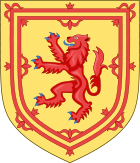- Princess Henrietta of England
-
Henrietta of Wales 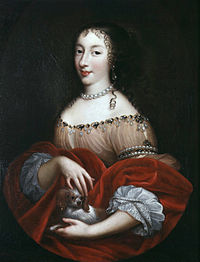
Painting by Mignard Duchess of Orléans Tenure 31 March 1661 – 30 June 1670 Spouse Philippe of France, Duke of Orléans Issue Marie Louise, Queen of Spain
Anne Marie, Queen of SardiniaHouse House of Stuart Father Charles I of England Mother Henrietta Maria of France Born 16 June 1644
Bedford House, Exeter, EnglandDied 30 June 1670 (aged 26)
Château de Saint Cloud, FranceBurial 4 July 1670
Royal Basilica of Saint Denis, FranceReligion Church of England
Roman CatholicHenrietta of England (16 June 1644 (26 June n.s.) – 30 June 1670) was born a Princess of England and Scotland as the youngest daughter of King Charles I of England and his consort Henrietta Maria of France. Fleeing England with her governess at the age of three, she moved to the court of her first cousin Louis XIV of France, where she was known as Minette.[1] After she married Philippe of France, brother of King Louis XIV, known as Monsieur at court, she became known as Madame.[2] Very popular with the court in no small part due to her flirtatious nature, her marriage was marked by frequent tensions.[3] Henrietta was instrumental in negotiating the Secret Treaty of Dover prior to her unexpected death in June 1670. Jacobite claims to the throne of Great Britain following the death of Henry Benedict Stuart descend from her through her daughter Anne Marie, Queen of Sardinia.
Contents
Infancy in England
Princess Henrietta of England was born at Bedford House in Exeter on 16 June 1644, on the eve of the Second Battle of Newbury during the English Civil War.[4] Her father was King Charles I of England, her mother the youngest daughter of Henry IV of France and Marie de' Medici. All her life, Henrietta would enjoy a close relationship with her mother, Queen Henrietta Maria. Her connections with the court of France as niece of King Louis XIII and first cousin of Louis XIV would prove to be very useful later in life.
Shortly before the birth of Henrietta, her mother had been forced to leave Oxford for Exeter, where she had arrived on 1 May 1644. Many thought she would not survive the birth due to her state of health at the time.[5] After a particularly difficult birth, the princess was put in the care of Anne Villiers, Countess of Morton, known at that time as Lady Dalkeith.[6] For the safety of the infant princess, the queen decided to make her way to Falmouth and then return to France to ask Louis XIV to assist her husband's war efforts. Arriving at Falmouth in mid July, the queen was informed that the infant princess had been taken ill with convulsions, from which she recovered. On 26 July, Henrietta met her father, Charles I of England, for the first time. Prior to his arrival, the king had ordered that the princess would be baptised in accordance with the rites of the Church of England, and she was baptised Henrietta at Exeter Cathedral on 21 July.[7] A canopy of state was erected in honour of her dignity as a Princess of England.[8] Henrietta was moved to Oatlands Palace outside London, where the princess and her household lived for some three months before fleeing secretly in June 1646, Lady Dalkeith ensured Henrietta's safe arrival to France where she was reunited with her mother.[9]
Life and marriage in France
While living at the French court, the princess was given the name Anne in honour of her aunt Queen Anne of Austria.[7] When she first arrived, she was known as Henriette d'Angleterre or the princesse d'Angleterre in France. She and her mother were given apartments at the Louvre, a monthly pension of 30,000 livres and the use of the Château de Saint-Germain-en-Laye. This lavish establishment soon diminished as all the money Queen Henrietta Maria received was given to her husband in England or to exiled cavaliers who had fled to France.[10] During the Fronde, the civil war that raged in France between 1648 and 1653, Henriette and her mother stayed at the Louvre.
In February 1649, Henrietta's mother was informed of the execution of her husband Charles I, who had been beheaded on 30 January. At the end of the Fronde, Queen Henrietta Maria and her daughter moved into the Palais Royal with the young Louis XIV and his mother and brother Philippe. At the same time, Queen Henrietta Maria decided to have her daughter, who had been baptised in the Church of England, brought up as a Roman Catholic.[11] With the arrival of Henrietta's brother, Henry Stuart, Duke of Gloucester, in 1652, their small court was increased.
After the Fronde was over, the French court put a priority on finding a bride for the young king of France. Queen Henrietta Maria hinted at the idea of a union between Henrietta and Louis, but Queen Anne rejected the idea, preferring instead her niece, the princess Maria Theresa of Spain.[12] Louis and Maria Theresa married in June 1660, after which Queen Anne turned her attentions to her unmarried son Philippe. While residing at the Château de Colombes, Henrietta Maria's personal residence outside Paris, mother and daughter heard of the restoration of the monarchy in England under Henriette's brother Charles II of England,[13] and they returned to Paris. This change of fortunes caused Philippe, a flamboyant homosexual who had been party to a series of sexual scandals, to ask Henriette to marry him. Prior to this Henrietta had received various proposals from Charles Emmanuel of Savoy and the Grand Prince of Tuscany but nothing came of them.[14]
An impatient Philippe was eager to make sure he married Henrietta as soon as possible, but Queen Henrietta Maria was intent on going to England to sort out her debts, secure a dowry for Henrietta and prevent the Duke of York's announcement of his marriage to Anne Hyde, a former maid-of-honour to the Princess Royal.[15] During this time, Henrietta became distraught when her brother the Duke of Gloucester died of smallpox in September 1660.[16] In October, Henrietta and her mother embarked at Calais for Dover, where they stayed at Dover Castle. The French court officially asked for Henrietta's hand on 22 November and her dowry was arranged. Charles II agreed to give his sister a dowry of 840,000 livres[17] and a further 20,000 towards other expenses. She was also given, as a personal gift, 40,000 livres annually and the Château de Montargis as a private residence.[18]
Henrietta's return to France was delayed by the death from smallpox of the Princess of Orange. She finally left England in January 1661. Returning to France, she and Philippe signed their marriage contract at the Palais Royal on 30 March 1661; the ceremony took place the next day.[19] The marriage was greatly celebrated and she and her husband moved into the Palais des Tuileries.[20] As she had married Monsieur, Henrietta was styled Madame, la duchesse d'Orléans.[21]
The marriage started well and Philippe seems to have been a doting husband. A year into the marriage, Henrietta gave birth to a daughter later baptised Marie Louise. The paternity of the child was doubted by the court who believed Louis XIV or the Count of Guiche, to be the father. Henriette and Guiche had started an affair early in her marriage, despite his having been a former lover of Philippe.[22] These flirtations caused a once adoring Philippe to become intensely jealous and he complained to Queen Anne, who reprimanded both Louis and Henrietta.
Scottish and English Royalty House of Stuart 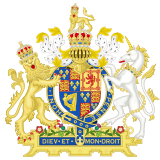
Charles I Charles II James II & VII Henry, Duke of Gloucester Mary, Princess Royal Henriette, Duchess of Orléans Elizabeth Soon after, Louis started an affair with one of Henrietts's ladies-in-waiting by the name of Louise de La Vallière, who had joined her household at the end of 1661 and had protected Henrietta with regards to her affair with Guiche. The couple's next child was a son born in July 1664 who was given the title Duke of Valois. The son, however, died in 1666 of convulsions after being baptised Philippe Charles hours before death. The loss of the little Duke of Valois affected Henrietta greatly.[23] She gave birth to a stillborn daughter in July 1665,[24] but another daughter was born in 1669 who was baptised Anne Marie in 1670.
In 1666, her husband's most prominent lover, the Chevalier de Lorraine, became attached to the Orléans household[25] – Lorraine would often vie for power within Philippe's household, an unusual arrangement for the time.
Henrietta has often been praised as a cultured princess and her correspondence with Moliere, Racine, La Fontaine, Bussy[disambiguation needed
 ] and others is notable.[26] She was also a lover of gardening, and it was she who created a water garden at the Palais Royal.[27] Henrietta also amassed a large and prestigious picture collection that included paintings by Van Dyke and Corregio.[28] Her active personality has caused historians to think that she showed signs of Anorexia nervosa.[29]
] and others is notable.[26] She was also a lover of gardening, and it was she who created a water garden at the Palais Royal.[27] Henrietta also amassed a large and prestigious picture collection that included paintings by Van Dyke and Corregio.[28] Her active personality has caused historians to think that she showed signs of Anorexia nervosa.[29]Late in 1669, Henriette lost her mother Queen Henrietta Maria, who died after having taken an excessive quantity of opiates as a painkiller.[30] Henrietta was devastated, and the situation was not helped by Philippe's immediate rush to claim all her possessions before she had even been buried.
Secret Treaty of Dover
Henriette was instrumental in diplomatic negotiations between her native England and adopted France. Her brother Charles II, with whom she had always been very close, had been trying to establish a closer relationship with France. Having been under discussion since 1663, it was not till 1669 that Charles II set the wheels into motion by openly admitting he would become a Roman Catholic and vowing to bring England under Roman Catholicism. Henriette was eager to visit her homeland and Louis XIV encouraged her in order for the treaty to take place. Philippe, however, annoyed with Henrietta for her flirting with Guiche and his previous lovers, remained adamant that she should not be allowed to go complaining to the English king and that she should remain at his side in France. Appealing to the French king, she managed to arrange for her to travel to England, where she arrived in Dover on 26 May 1670, remaining there till 1 June, the day the treaty was signed.[31]
Charles was to abandon England's Triple Alliance with Sweden and the Dutch Republic in favor of assisting Louis XIV in conquering the Dutch Republic, which he claimed for his wife Queen Marie Thérèse as part of her unpaid dowry. Provided that the conquest was successfully completed, England was promised several very profitable ports along one of the major rivers that ran through the Dutch Republic. The treaty did not become public until 1830.[32] After her time in England, she returned to France on 18 June.[33]
Death, burial and aftermath
In 1667 Henrietta began complaining of an intermittent, intense pain in her side. Beginning in April 1670, according to reports, Henrietta began having digestive problems so severe that she could consume only milk.[34] Returning to France after the treaty, Henrietta went to stay at Saint Cloud with her husband on the 26 June.[35] On June 29, at five o'clock, Henrietta drank a glass of chicory water. According to reports, immediately after drinking the water she felt a pain in her side and cried out, "Ah! What a pain! What shall I do! I must be poisoned!".[36] She immediately assumed she had been poisoned and asked both for an antidote and for someone to examine the chicory water.[34] She was given common contemporary treatments for colic, as well as anti-poisons.[34] The royal family arrived at Saint Cloud having heard the news within hours. Bishop Bossuet was called and later administered the Sacrament. At 2 o'clock in the morning of June 30, 1670, Princess Henrietta died.[29]
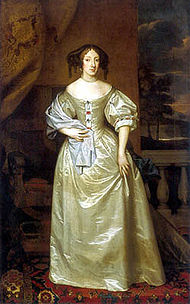 A posthumous painting of Henrietta commissioned by her brother and painted by Samuel Cooper.
A posthumous painting of Henrietta commissioned by her brother and painted by Samuel Cooper.
The Chevalier de Lorraine and the Marquis d'Effiat were rumored by many to be accomplices in poisoning Henrietta.[29] Seventeen French and two English physicians, the British ambassador and roughly one hundred other onlookers observed the autopsy, and though the official report stated "death from cholera morbus (gastroenteritis) caused by heated bile," many observers disagreed.[34]
Henrietta was interred at the Royal Basilica of Saint Denis on July 4, another service was held on 21 July. All chief public bodies including the Parliament, courts of Law, Assembly of the Clergy and the City Corporations were represented, as well as members of the nobility and general public. Queen Maria Theresa was present with the king of Poland, John II Casimir, and the English Ambassador, the Duke of Buckingham. French Princes of the blood were present as well as masses of the nobility.
"Last of all came the members of Monsieur and Madame's household, bearing torches in their hands. A mausoleum, surrounded with altars and silver urns, and adorned with a crowd of mourning allegorical statues, among which Youth, Poetry and Music were conspicuous, had been erected in the centre of the choir. There the coffin rested, covered with cloth of gold, edged with ermine, and embroidered with the arms of France and England in gold and silver. Everyone having taken their places hundreds of candles burst into flame giving a cloud of incense; and the Archbishop of Reims assisted by other bishops, began the mass, which was chanted by the King's musicians organized by Lully."[37] Monsieur married again in 1671 to Elizabeth Charlotte of the Palatinate, who, like Henrietta, was descended from Mary, Queen of Scots, sharing James I of England as a common ancestor.[38] Monsieur and the "new Madame" would have a further two surviving children.
Henrietta's eldest daughter Marie Louise died like her mother at the age of 26 in Spain in 1689.[39] The circumstances of her death were almost identical to those of her mother's death, and she was also believed to have been poisoned.[40] Anne Marie married in 1684 and was the mother of some eight children, the eldest of which, Princess Maria Adelaide, was the mother of Louis XV. She also died at the age of 26. Monsieur himself would die in 1701.[41] Her descendants include Henri, Count of Paris, the Orléanist pretender to the French throne, the king of Spain, the king of the Belgians, the grand duke of Luxembourg and the pretender to the Italian throne.[42]
Issue
- Marie Louise d'Orléans (26 March 1662 – 12 February 1689) married Charles II of Spain, no issue.
- Philippe Charles d'Orléans, Duke of Valois (16 July 1664 – 8 December 1666).
- Stillborn daughter (9 July 1665).
- Anne Marie d'Orléans (27 August 1669 – 26 August 1728) married Victor Amadeus II, Duke of Savoy (future king of Sardinia) and had issue.
Ancestors
Ancestors of Princess Henrietta of England 16. Matthew Stewart, 4th Earl of Lennox 8. Henry Stuart, Lord Darnley 17. Margaret Douglas 4. James I of England 18. James V of Scotland 9. Mary, Queen of Scots 19. Mary of Guise 2. Charles I of England 20. Christian III of Denmark 10. Frederick II of Denmark 21. Dorothea of Saxe-Lauenburg 5. Anne of Denmark 22. Ulrich III of Mecklenburg-Schwerin 11. Sofie of Mecklenburg-Schwerin 23. Elizabeth of Denmark 1. Princess Henrietta of England 24. Charles de Bourbon, Duke of Vendôme 12. Antoine of Navarre 25. Françoise d'Alençon 6. Henry IV of France 26. Henry II of Navarre 13. Jeanne III of Navarre 27. Marguerite de Navarre 3. Henrietta Maria of France 28. Cosimo I de' Medici, Grand Duke of Tuscany 14. Francesco I de' Medici, Grand Duke of Tuscany 29. Eleonora di Toledo 7. Marie de' Medici 30. Ferdinand I, Holy Roman Emperor 15. Johanna of Austria 31. Anna of Bohemia and Hungary Titles, styles, honours and arms
Titles and styles
- 16 June 1644 – 31 March 1661 Her Royal Highness Princess Henrietta of England
- 31 March 1661 – 30 June 1670 Her Royal Highness Madame, Duchess of Orléans
In Film & Television
- In the 2003 mini-series, Charles II: The Power & The Passion, Henrietta is played by Anne-Marie Duff
- In the 2009 film, Broadside, Henrietta is played by Jessica Clarke
- In the 2010 short film, Minette, Henrietta is played by Jenna Brighton
References
- ^ Barker, p. 75
- ^ Barker, p. 72
- ^ Barker, p. 78
- ^ Cartwright, p. 2
- ^ Cartwright, p. 3
- ^ Cartwright, p. 4
- ^ a b Fraser, p 32
- ^ Cartwright, p. 5
- ^ Cartwright, p. 13
- ^ Cartwright, p 18
- ^ Cartwright, p. 28
- ^ Fraser, p. 67
- ^ Cartwright, p. 68
- ^ Cartwright, p. 62
- ^ Cartwright, p. 67
- ^ Cartwright, p. 69
- ^ Barker, p 125
- ^ Cartwright, p 70
- ^ Cartwright, p 81
- ^ Cartwright, p 90
- ^ Fraser, 321
- ^ Cartwright, p 106
- ^ Barker, p 115
- ^ Mitford, p 87
- ^ Cartwright, p 239
- ^ Cartwright, p 179
- ^ Fraser, p 76
- ^ Fraser, p 77
- ^ a b c Fraser, p 155
- ^ White, Michelle A: Henrietta Maria and the English Civil Wars. Aldershot, Ashgate Publishing, 2006, p 193
- ^ Fraser, p 151
- ^ Fraser, Antonia: Royal Charles: Charles II and the Restoration, Alfred A. Knopf, New York, 1979, p 276
- ^ Cartwright, p 336
- ^ a b c d Baron, p. 214
- ^ Fraser, p 153
- ^ Cartwright, p 345
- ^ Cartwright, p 383
- ^ Barker, p 123
- ^ Fraser, p 277
- ^ Baron, p. 215
- ^ Barker, p 234
- ^ Barker, p 239
Bibliography
- Barker, Nancy Nichols: Brother to the Sun King; Philippe, Duke of Orléans, Johns Hopkins University Press, Baltimore/London, 1989
- Cartwright, Julia: Madame: A life of Henrietta, daughter of Charles I and Duchess of Orléans, Seeley and Co.Ltd, London, 1900
- Fraser, Antonia: Love and Louis XIV; The Women in the Life of the Sun King, Anchor Books, London, 2006
- Fraser, Antonia: Royal Charles: Charles II and the Restoration, Alfred A. Knopf, New York, 1979
- Mitford, Nancy: The Sun King, Penguin Publishing, London, 1966, ISBN 0-14-023967-7
External links
- Funeral oration of Henriette d'Angleterre, Duchess of Orléans by Bossuet
- Henriette d'Angleterre at Genealogics
See also
House of Stewart Robert II John, Earl of Carrick (later King Robert III) | Walter, Lord of Fife | Robert, Duke of Albany | Alexander, Earl of Buchan | David, Earl of Strathearn | Walter, Earl of AthollRobert III James I James II James III James IV James V Mary I James VI Charles I Charles II of England | James II of England | Henry, Duke of Glouchester | Mary, Princess Royal and Princess of Orange| Henrietta, Duchess of Orléans | Princess Elizabeth | Princess AnneJames VII Mary II (none)Anne Princesses of France by marriage 1st generation None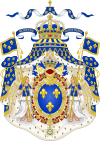
2nd generation 3rd generation Princess Henrietta of England · Elizabeth Charlotte of the Palatinate4th generation 5th generation 6th generation None7th generation 8th generation Archduchess Maria Antonia of Austria · Princess Maria Giuseppina of Savoy · Princess Maria Teresa of Savoy9th generation 10th generation Archduchess Maria Theresa of Austria-Este*also a princess of France in her own rightPrincess Blanche of France (1345-1376) · Valentina Visconti (1389-1407) · Isabella of Valois (1407-1409) · Bonne d'Armagnac (1410-1430) · Maria of Cleves (1440-1465) · Princess Jeanne of France (1476-1498) · Catherine de' Medici (1533-1547) · Marie de Bourbon (1626-1627) · Princess Marguerite of Lorraine (1632-1660) · Princess Henrietta of England (1761-1670) · Elizabeth Charlotte of the Palatinate (1672-1701) · Françoise Marie de Bourbon (1701-1732) · Margravine Johanna of Baden-Baden (1724-1728) · Louise Henriette de Bourbon (1752-1759) · Louise Marie Adélaïde de Bourbon (1785-1793) · Princess Maria Amalia of Naples and Sicily (1809-1830) · Duchess Helene of Mecklenburg-Schwerin (1837-1842) · Princess Marie Isabelle of Orléans (1864-1894) · Archduchess Maria Dorothea of Austria (1896-1926) · Gersende de Sabran-Pontèves (1969-present)Categories:- 1644 births
- 1670 deaths
- English princesses
- Scottish princesses
- 17th-century English people
- 17th-century French people
- French Roman Catholics
- Princesses of France (Bourbon)
- Princesses of France (Orléans)
- House of Stuart
- House of Orléans
- Protestant monarchs
- Burials at the Basilica of St Denis
- House of Bourbon (France)
- House of Bourbon
- People from Exeter
- English people of French descent
- Duchesses of Chartres
- French royalty
- Duchesses of Valois
- French princesses
- French duchesses
- Duchesses of Orléans
- Deaths from peritonitis
Wikimedia Foundation. 2010.


